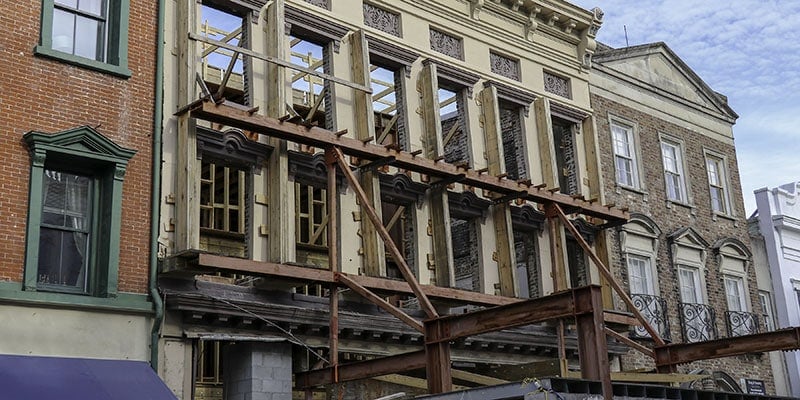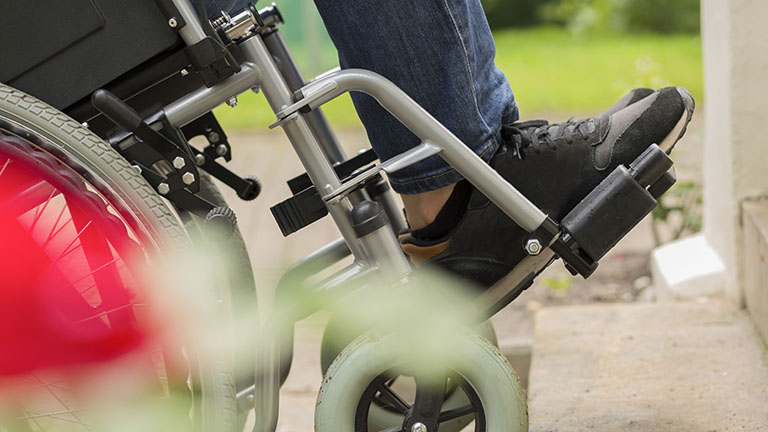Any renovation could potentially trigger ADA requirements. If you remodel a building that is not a private home, chances are the ADA will apply. From schools to conference centers, churches to hotels, restaurants to corporate offices, hospitals to performing arts complexes… the Americans with Disabilities Act (ADA) plays a role in all of them.
Does Every Single Part of the Space Have to be Accessible?
If the zones you are modernizing don’t meet the ADA, you will need to include some changes. For example, if you remodel a main assembly space that has a large stage, you would need to include a ramp or wheelchair lift for “handicap access” to the stage.
However, you can run into problems if you are altering a section of your facility that has several small meeting rooms, narrow hallways, small restrooms, and separate stairs into each room. Making everything accessible might cost five times what the original renovation would have cost.
In cases where providing for complete access would be cost prohibitive (or where it would not be technically feasible) you may not have to fix absolutely everything. The cost of making an accessible path of travel should not be “disproportionate” to the project.
A standard rule of thumb is that you can reasonably expect your ADA updates to make up 20% of the total cost of the project. If the price tag for complete accessibility is much more than 20%, then you should start prioritizing. Entrances and routes to primary function areas usually get priority over things like storage closets.
Here’s a great place to start when looking for specifics on how to set these priorities: Guide to the ADA – Alterations and Additions.
If I am Restoring or Preserving a Historic Building, How Will I Need to Comply?
As you may have noticed in the document link above, ADA requirements can be more flexible for historic buildings.
Even if your building is not on any specific historic list, but it has some local historic significance, consider asking your local code officials about helping you strike a balance between accessibility and historic preservation. City officials may also be more lenient simply because a building is in a historic district.
Read: 6 overlooked ADA compliances
Should I Consider Providing Access Even if I am not Required by Law to do so?
What if you want to provide wheelchair access even if you are not required to provide access? Wonderful! You will join the many facility owners and business managers who seek to provide the best accommodations for their members, guests, and patrons rather than merely meeting the minimum requirements of the law.
Let’s say your church building committee is planning to modernize the 60-year-old kitchen in Fellowship Hall. Suppose they also decide to have wheelchair access to the platform in the church sanctuary even though the kitchen renovation doesn’t require it. Why would they want to?
- Well, maybe your praise band drummer is in a wheelchair, or
- Your choir might have several people who use canes and walkers, or
- Perhaps most of your church members will eventually read liturgy from the platform, and your congregation already has several people in wheelchairs, or
- Possibly your development team has decided that, since the surrounding community has quite a few wheelchair users, attracting those people and their families would benefit the congregation.
If the church decides to get a wheelchair lift for the sanctuary during the kitchen remodel, there might be reasons to include it in the same budget.
Of course, the lift could be a stand-alone or parallel project as well. It could even be much simpler than a sanctuary renovation. Instead of building a long ramp or modifying a room in back of the stage to accommodate a lift, the church could consider getting a high-end portable wheelchair lift as a stand-alone piece of equipment. Then, all you have to do is set it up when you need it.
What Are You Waiting For?
Don’t wait until it’s too late. If your facility is open to the public, you will want to find out how ADA compliance applies to any renovations you plan. With a little bit of advanced planning, you can be assured of a complete (and compliant!) renovation project with no ghastly surprises at final inspection. What’s more, the requirements are often quite reasonable, even desirable, when you get into the details.
In the long run, you might notice that your ADA modifications actually attract new patrons. Who knows… you may find that your resulting new memberships and sense of goodwill in the community more than offset the initial expense of providing superior accessibility for everyone.
Testimonials
“We purchased an Ascension lift when we renovated our Municipal Auditorium. We had seen stage lifts before that were unattractive, blocked the view of the stage and were generally ‘in the way’. The ascension lift is attractive and rests entirely below the stage level when not in use. More importantly, when it is not needed, it can be rolled off into the store room where it is completely out of sight and out of the way. We did have a few issues when we first received our lift, but I am happy to say that the staff at Ascension was very helpful and made sure that our lift was working and fully met our expectations. You can find cheaper lifts out there, you won’t find a better lift for your public facility.”
Paul L. Adams, Director of Parks & Recreation
City of South Gate
South Gate, CA
“Southern Hills Arts Council, Jackson, Ohio, is renovating a 1930 Art Deco movie house to serve as a community cultural arts center. When we began to work on the auditorium, we knew we would want some method of access for those who either need a wheelchair or for whom the stairs are a bit too much. We installed an Ascension lift and are quite happy with this piece of equipment. First and foremost, it is safe and easy to operate. It is of sufficient capacity that a mobile person can ride up and down with a less mobile individual, providing an extra sense of security. We like the fact that the lift can be raised onto wheels in short order and moved. Because we are renovating in stages, we have had to move the lift to accomplish a couple of phases, such as treating the concrete floor. We are nearly as pleased with the look of this lift as its many practical aspects. Throughout this renovation, we have worked tirelessly to create a beautiful space. Frankly, we were worried that a lift would mar our efforts. We even spoke of trying to hide the piece under a cover. When we saw the Ascension, we knew instantly that this would not be necessary. The sleek black design, lack of a tower, and ample use of glass help the Ascension lift blend in without troubling the eye. In short, we are pleased with our new Ascension and hope this piece of equipment will serve us well into the future.”
Barbara Summers, Executive Director
Markay Cultural Arts Center
“Just a quick note to comment on your terrific product that is being used in our high school building. The Ascension vertical portable wheelchair lift has proven to be an invaluable asset to the school’s needs. The very first time it was used in the public was a roaring success. Just the thought of including our students with special needs to no longer go through embarrassing moments of painfully attempting a stair climb was delightful. The ease of transporting our valuable cargo into the spotlight that they so deserved was simply astounding. The care and maintenance of your lift is equally as appreciated as its functionality. A big thanks from myself, staff and the administration has been given to the Buffalo Board of Education for supplying our newly renovated building with such a helpful and quality product.”
Patrick Downs, Chief Stationary Engineer
Buffalo Public Schools
Buffalo, NY
“We have been using the lift now for a while. We are very pleased with its performance. It is used by anywhere from 1 to 12 different individuals each week. We did a major renovation to our Kingdom Hall so as to accommodate the lift and update the premises. The lift is in the foyer for easy access. We would have no problem recommending the Ascension Virtuoso 4860P Lift as a well-made, reliable, and easy to use product. Thank you for all you have done on our behalf.”
Michael van der Mout
Kingdom Hall of Jehovah’s Witnesses
Halifax, NS Canada



